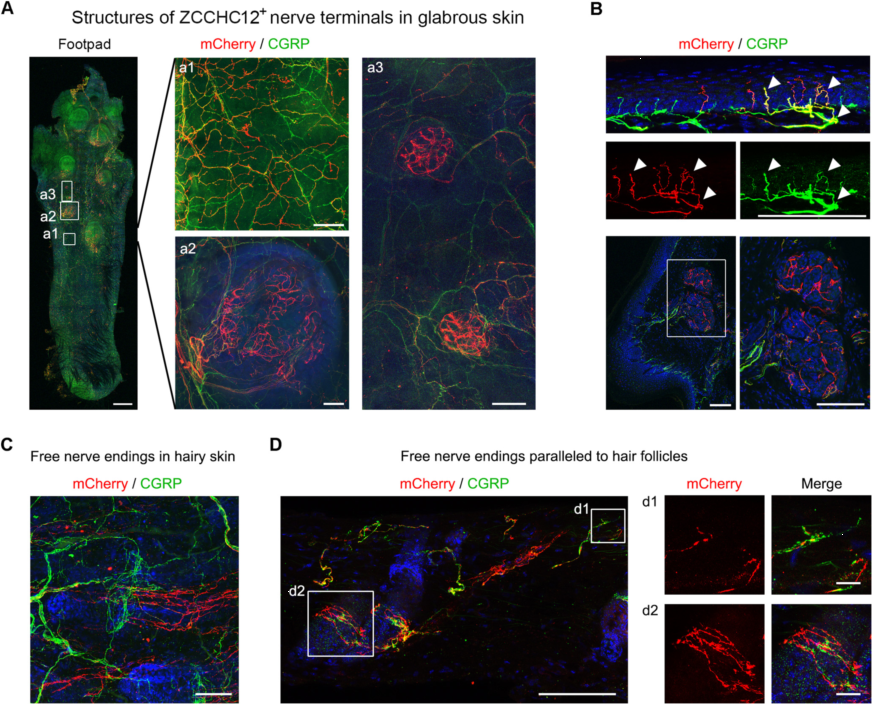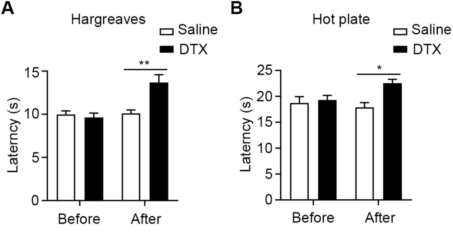Dr. Changlin Li’s Laboratory at Guangdong Institute of Intelligent Science and Technology (GDIIST) is committed to exploring the mechanisms underlying somatosensory development and diseases by performing single cell analysis systematically. Recently, laboratory of somatosensory development and diseases has made important progress in studying the morphology and function of the newly discovered Zinc-finger CCHC domain containing 12 (Zcchc12) neurons with the smallest diameter in dorsal root ganglion (DRG). The article "Zcchc12-Containing Nociceptors Are Required for Noxious Heat Sensation" was published in The Journal of Neuroscience on March 30. In this paper, gene expression, terminal morphology and central projections of Zcchc12+ neurons were described in detail by in situ hybridization, immunohistochemistry. They also proved that the Zcchc12+ neurons functioned as polymodal nociceptors sensitive to thermal and mechanical stimulation by in vivo calcium imaging, and were required for noxious heat sensation. The study is important for understanding cellular mechanisms of somatosensory functions.
Zcchc12+ cluster is one of the subtypes with the smallest diameter. To study the terminal morphology and central projection, the Zcchc12-CreERT2 transgenic mice were constructed and infected with AAV2/9-CAG-LINE-DIO-mCherry virus. The soma and nerve endings of Zcchc12+ neurons could be specifically labeled by the fluorescent protein mCherry after tamoxifen induction. They demonstrated that Zcchc12+ neuron was a subset of galanin-expressing DRG neurons. Almost all the Zcchc12+ neurons expressed substance P and about half of those expressed CGRP. Zcchc12+ fibers mainly innervated laminae I and II outer of spinal cord. Whole-mount immunohistochemistry result showed the Zcchc12+ nerve endings were widely distributed in the glabrous and hairy skin. Most of the labeled free nerve endings were co-expressed with CGRP. The Zcchc12+ clustered dense terminals were observed within and surrounding the derma of the footpad, which has never been termed or functionally studied before. They were neither Nefh nor CGRP-containing endings, which suggested a new type of Zcchc12+ circumferential endings.
To study the functions, the researchers adopted in vivo two-photon calcium imaging on the Zcchc12-CreERT2 mice infected with AAV2/9-CAG-FLEX-GCaMP6s virus. The Zcchc12+ neurons were significantly responded to noxious heat, cold and mechanical stimuli, but not to innocuous air puff and brush. The researchers ablated the Zcchc12+ neurons on the Zcchc12-CreERT2: AviliDTR transgenic mice with diphtheria toxin treatment. The ablation of Zcchc12+ neurons significantly increased the latency of withdrawal of the hind paw receiving noxious heat stimulation, with no difference in responses to noxious mechanical and cold stimuli. Finally, the researchers found that Zcchc12+ neurons are not involved in the initiation and maintenance of neuropathic pain. This study is the first to describe the morphology and function of Zcchc12+ neurons detailly. This paper provides the way of research strategies for studying different neuronal groups and subpopulations under the new classification framework, which is important for studying the molecular mechanisms of somatic sensation.
Dan Wu, a PhD student of CAS Center for Excellence in Brain Science and Intelligence Technology, and Dr. Yan Chen, from GDIIST, are the co-first author of this paper. Dr. Changlin Li, a principle investigator of GDIIST, and Dr. Xu Zhang, a CAS member, are the co-corresponding authors of this paper. This work was supported by National Natural Science Foundation of China, Chinese Academy of Sciences, Special Fund for Science-Technology Innovation Strategy of Guangdong Province, Science and Technology Commission of Shanghai Municipality, and Innovation Fund for Medical Sciences of Chinese Academy of Medical Sciences, Shenzhen Sanming Project, and GDIIST.

Fig.1 Zcchc12+ DRG neurons peripherally innervated various cutaneous receptors in skin

Fig.2 Zcchc12+ DRG neurons were necessary for noxious heat sensation
Article links: https://www.jneurosci.org/content/42/13/2690.long


